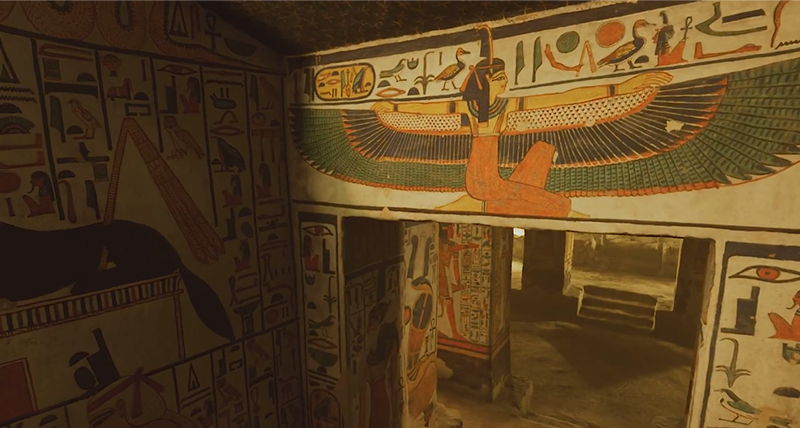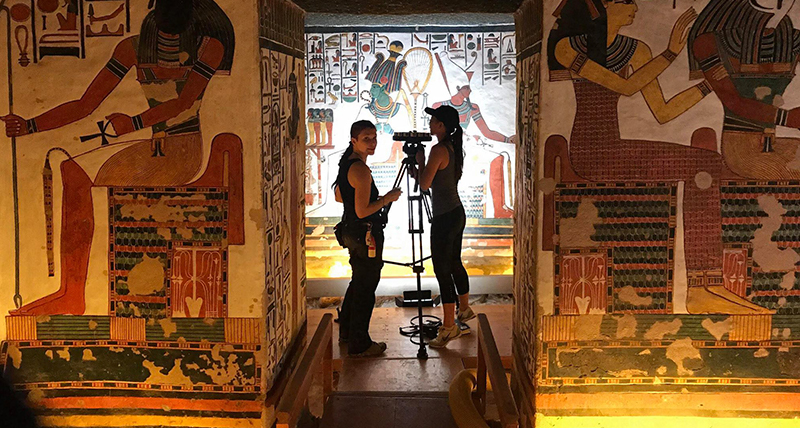Capturing Egypt’s Sistine Chapel with the BLK360
Video case study

Author: Reka Vasszi
Queen Nefertari’s 3,000-year-old tomb was captured with 3D laser scanning cutting-edge technology to generate a Virtual Reality (VR) experience of one of ancient Egypt’s most beloved ruler’s “Journey to Eternity.” In this ground-breaking project, thanks to the conjunction of the Leica BLK360 and VR technologies, viewers can fully immerse and explore the ancient tomb and the wall paintings.
Using the smallest imaging laser scanner and photogrammetry technology, ExperiusVR, a full-service virtual and augmented reality studio, and Curiosity Stream, the award-winning streaming destination, captured Queen Nefertari’s remarkable tomb in the Valley of the Queens. The team of experts generated a detailed 3D point cloud of the chambers to preserve it and make it accessible in VR for future generations.
“The capture of Nefertari’s tomb proves there are no boundaries in the effort to digitally preserve and explore our world’s most stunning cultural artifacts,” said Clint Stinchcomb, president and CEO of CuriosityStream.
Preserving Egypt’s Sistine Chapel digitally

Queen Nefertari was the most beloved wife of Ramses II. Still, after her death in 1255 BC, the eternal love and respect of her husband is presented intact as painted artworks on the walls of the royal chambers of what has been named Egypt’s Sistine Chapel.
Restricted to visitors since the 1950s, the ancient tomb has extremely limited access as the wall paintings are vulnerable to the humidity of visitors' breath, which increases fungi causing damage to the artworks.
Nefertari’s tomb has both cultural and scientific significance, as it depicts the architecture of Ramses II era and it is the most detailed representation of ancient Egyptian believes of the journey to the afterlife. It would be a great loss if its beauty and historical richness could not be preserved and presented for the public.
“A virtual tour will save the tomb,” said Zahi Hawass, an archaeologist and former Minister of State for antiquities. As the tomb is restricted to tourists, ExperiusVR and Curiosity Stream had the vision to create an immersive VR experience by capturing every detail of Nefertari’s tomb with the BLK360.
An efficient workflow was set registering the point cloud with Leica Cyclone processing software and combining data in Autodesk’s ReCap PRO mobile to create the 3D models for VR.
The team used the BLK360 for secondary geometry and scale accuracy. Laser scanning was followed by overlapping thousands of DSLR photographs to the point cloud, creating an identical reconstruction of Nefertari’s tomb navigable in VR.
Staying connected below ground

One of the requirements when Steven Frisbey, technical director at ExperiusVR, was deciding on which 3D laser scanner to choose was reliable WiFi connection. As the chambers are built two levels underground, ExperiusVR experts were faced with the challenge of losing wireless connection. The reliability of the BLK360 completely surprised the ExperiusVR team who had to overcome the challenge of staying connected below ground and capturing data in limited time.
“The first thing that stood out to me about the BLK360 was WiFi. The second thing that impressed me is the speed of the scans and the ease of use. It was so fast that we could finish up the entire set a day in advance, which saved us a solid amount of money. I will definitely use the BLK360 in all of my next projects,” said Frisbey.
Digital heritage - the meeting point for tourism and education

Leveraging the technology of Leica Geosystems to embrace and preserve the original spirit of Nefertari’s royal tomb through 3D laser scanning and VR, the ancient site has been digitally reopened to the world. This immersive VR experience brings heritage preservation, tourism and education to a next level. Nefertari’s tomb is one of a growing number of archaeological sites that are being preserved digitally thanks to laser scanning technology.
“Now, because of this project, regardless of what happens to the real-life tomb, we'll always have a fully-explorable version that can be appreciated for generations to come. And that’s the thing that makes us the most proud about this project,” said Frisbey.
Our Latest News
Contact Leica Geosystems
Want to learn more? We're here to answer your questions.
Want to learn more? We're here to answer your questions.
























